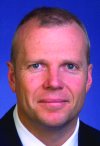Gauging the health of the world’s foreign exchange market is an awkward business, but every three years the Bank for International Settlements takes its pulse as best it can. Edward Russell-Walling reports.
The last time the Bank for International Settlements (BIS) brought out its stethoscope, in 2001, the FX heart was found to be beating rather feebly. But the bank’s latest survey shows it to be pounding. Daily turnover shot up from an average of $1200bn in 2001 to nearly $1900bn this year, according to BIS.
That represented a rise of 57% (36% at constant exchange rates), which was rather more than most anticipated. The consensus had been for closer to $1500bn. “We were all surprised,” admits Mansoor Mohi-uddin, UBS chief currency strategist. “No-one expected the jump to be this much.”
The gap was partly explained by the fact that 2001 was abnormally depressed, registering a 20% fall from the 1998 daily average of around $1500bn. But in 2001, a number of unusual influences also all came together at the same time. Chief among them was the disappearance, not long before, of 11 European legacy currencies, to be replaced by the euro.
That was accompanied by continued consolidation in the banking industry and a subsequent fall in the number of market participants. A third influence was the onward march of electronic broking in the interbank market. This reduced trading by simplifying the price discovery process and by reducing the scope for leveraged trading.
This year’s survey was carried out, as before, in April. Fifty-two central banks and monetary authorities gathered information on turnover in the spot, outright forwards and FX swaps markets. In a parallel exercise, they collected similar data for the over-the-counter currency and interest rate derivatives markets, which have shown even more spectacular growth since 2001, rising 112% to $1200bn. Daily turnover in FX derivatives rose by 109%, to $140bn.
Figures under scrutiny
Because of the way the survey is conducted, some speculate that the extraordinary increase in traditional FX trading is due, in part, to the 2001 numbers being unrealistically modest.
Drew Bradford, head of institutional FX sales at Deutsche Bank, says: “In my personal view, the 2001 figures were too low. April 2001 was one of our lowest turnover months for that year and, if it was ours, it was probably the market’s as well. I believe the real number was more like $1600bn.”
Drew Bradford: ‘The 2001 figures were too low’
April 2004, however, was “pretty normal”, he reckons. “So $1900bn is a real number. The market has definitely grown, but not by the 59% that they suggest.”
Whatever the true scale of the growth, it is visible across all segments, with spot transaction turnover up 60% to $621bn, according to BIS. Outright forwards are up 59% to $208bn, and swaps up 44% to $944bn. As a general backdrop, the markets are more sanguine this year than they were in 2001, but there have been other identifiably specific developments powering much of this activity.
One of the most important, by common consent, is the increased participation in the market by money managers, in general, and hedge funds, in particular. The statistics acknowledge this by showing that trading between banks and other financial institutions rose significantly, with its share of total turnover climbing from 28% to 33%.
“The higher activity between reporting banks and financial customers may have reflected a sizeable increase in activity by hedge funds and commodity trading advisers, as well as robust growth of trading by asset managers,” observed the BIS report on the survey’s preliminary results. This is in contrast to 2001, when hedge funds were notable by their absence.
Bucking the trend
“Foreign exchange is a counter-cyclical asset class,” points out Mark Warms, chief marketing officer of FXall, the electronic trading platform. “So when equities lost their lustre, the FX market became more interesting. For the last three years, conditions have been right for the market to take off.”
Mark Warms: chief marketing officer of FXall
Noting that the share of turnover with reporting dealers was down yet again (as opposed to the increased share of both financial and non-financial customers), Mr Warms says that their place is being taken by asset managers of one shade or another, who find FX easy to trade – not least because margin requirements are lower than for other asset classes. “And asset managers are trading more globally than in the past,” he adds.
The FX market has its own distinct attractions for traders and speculators, being both liquid and inefficient, according to Mr Bradford. “It’s a good market to trade because it’s very liquid,” he says.
“It also has participants that are non-profit seeking, such as tourists, central banks and corporates. That makes it inefficient. So capital which traded in markets that are getting more efficient has been coming into foreign exchange.”
Technology driver
Another key contributor to the market surge has been technology, as more and more of the smaller, plain vanilla transactions migrate to electronic trading platforms. “The rise of electronic trading has significantly contributed to increased volumes,” maintains Mr Warms.
Apart from allowing investors to keep track of positions and margin changes, it also lets them use more aggressive black-box trading models, he says. “And it enables them to put more volume through the market in a shorter space of time.”
Peter Nielsen, Royal Bank of Scotland’s global head of FX, agrees. “The advent of electronic platforms has made trading dramatically easier,” he says. “It has brought down transaction spreads and reduced dealing costs. As in other markets where costs have been reduced, the FX market has garnered additional participants.” Most notable among them, he adds, are “high frequency” players in the shape of various types of investment vehicle, both leveraged and unleveraged.
US share on the up
The growing presence of money managers in the market almost certainly accounts for another notable feature of the BIS numbers – the growing US share of turnover, up from 16% to 19%. “A number of these high frequency players are based either in New York or Chicago,” Mr Nielsen observes.
While Japan’s share of turnover slipped slightly from 9% to 8%, the UK – London, in other words - remains the geographical centre of the market, with a steady 31%.
“It’s the time zone, more than anything,” explains Mr Bradford. “Three-quarters of our global FX volume happens between 8am and 5pm London time, though that does include New York’s morning and Asia’s late afternoon.
“New York’s growth in share is due to the leveraged market. A lot of commodity trading advisers and hedge funds are US-based companies.”
When it comes to the currencies themselves, the US dollar is still the undisputed overlord, involved in 89% of all trades (90% in 2001). No one expected otherwise. In the number two slot is the euro, whose share remains the same at 37%. The yen slid from 23% to 20%.
Slightly less predictable has been the growing presence of sterling, which has increased its share in every survey since its nadir (9% post-Black Wednesday) in 1995. This year it claims 17%, up from 2001’s 13%.
“The US dollar is still very dominant, which is no real surprise,” says UBS’s Mr Mohi-uddin. “Sterling, on the other hand, has become more important to central banks, according to the latest International Monetary Fund data. It’s favoured more than the yen by developing country central banks, which is astonishing when you compare the size of the Japanese and UK economies.”
Diversified holdings
High UK interest rates, it seems, have more than compensated for relative economic proportions. As Mr Mohi-uddin points out, central banks – particularly in Asia – have become more important players in the past few years. While the US dollar has been weakening, they have been diversifying their considerable FX holdings into non-dollar currencies, such as the euro, sterling, Australian dollar and yen.
That helps explain why the Australian dollar has gradually increased its slice of turnover from under 3% in 1992 to well over 5% this year. By contrast, low interest rates and the rise of the euro have deflected attention from the Swiss franc – hence its slow decline from 10% of the market in 1989 to 6% this year.
Mr Bradford attributes volume growth in the Mexican peso (nearly doubled to 1%) and other Latin American currencies to the fact that assets in that region are coming back in vogue. “A lot of assets in the first world look expensive,” he says. “Latin American assets are viewed as good value.”
What will the next set of BIS numbers look like three years from now? Pretty good, according to most, as long as the world economy doesn’t nosedive. Mr Bradford thinks average daily turnover could hit $2100bn.
And, of course, there’s always the China effect, just waiting to happen. “It won’t be long before the Chinese currency becomes freely traded,” predicts Mr Warms. “When that happens, it will be up there with the dollar and the euro. Trading will go through the roof.”




